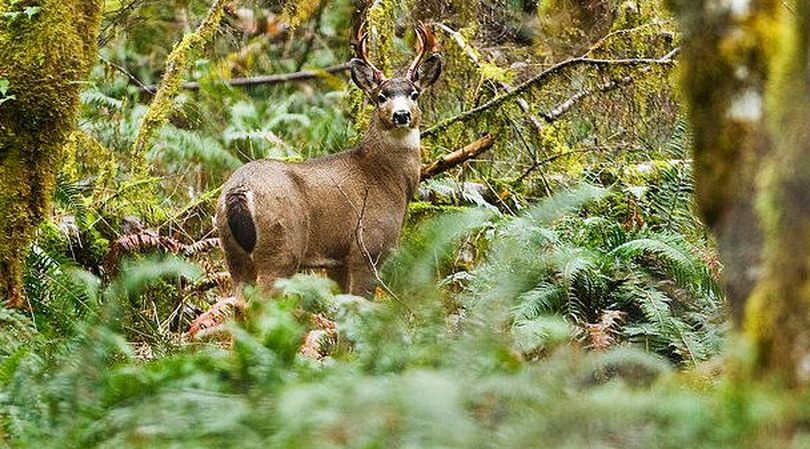Formula offered for tagging a West Side blacktail buck

HUNTING -- Whitetail bucks are famous for taking advantage of thick cover to live long and grow big racks.
But even the white-tailed deer of Eastern Washington and North Idaho could take a lesson from Western Washington blacktails, where the average hunter can expect to devote something like 30 days in the field per buck.
Click "continue reading" for a report by Alan Thomas of the Vancouver Columbian on what it takes to to west of the Cascades and make a blacktail hunt successful.
By ALLEN THOMAS/The Vancouver Columbian
State wildlife biologist Eric Holman spends hundreds of hours a year in the woods chasing deer as part of his job, which includes a study of fawn survival in the Washougal and Coweeman game units.
He counts deer in late December in the Rock Creek drainage of eastern Klickitat County to determine how many bucks — compared to does — survived hunting season.
He participates in the fawns-to-adult tally in March in Klickitat County. He hunts big-game himself.
When I asked him what he'd tell a newcomer to deer hunting in Southwest Washington his answer was immediate, without any pause for thought:
"Go any place that you're familiar with,'' Holman said.
Blacktail deer hunting in the brushy woods of Southwest Washington is so much about effort, he said.
"An awful lot has to do with, and it sounds kind of silly, with just how hard you try,'' Holman said. "You really have to hunt them seriously if you really want to have some success with it.''
For many hunters, it's as much about the hunting experience as killing a deer, he said.
"For a lot of people, I just think it's an enjoyable time to get out. They want to go with their friends and want to go a couple of days, take the truck out, peek off a couple of landings and give it a try.
"Sometimes, you get a deer that way. It works. Certainly during the late buck season it works.''
But for hunters to have a high success rate more intensity is involved.
"The people who are more successful at it are out there in the black of morning,'' he said. "They've creeped out to some spot they may have scouted and they know there's some deer food and they might have found trails or even seen some deer there before.''
Holman noted that the average is 30 to 35 days of hunting per blacktail deer kill.
"If you really try hard and keep at it you're probably going to have an opportunity to get a deer,'' he said. "But if you go one or two days in the fall, then the math of it is stacked terribly against you.''
Another suggestion he had is to intensely hunt a small area.
"These deer typically live in a pretty small range. But hunters will drive a lot or walk fast and they don't look very long at any one place. These deer are difficult to see in the habitat they favor.
"A deer lying down…that thing's head is only 18 inches off the ground,'' he said. "That's tough to spot in vegetation that's typical here. Just because you look out along the edge of a clearcut and don't see something doesn't mean there no deer there.
"The people who hunt more seriously and have more patience are the ones who are more successful.''
Gene Ritter of Vancouver, who shot his first deer in 1954 in Klickitat County, said his advice is to concentrate on the fringes of the urban areas.
"I'd try the urban areas,'' he said. "Silver Star (Mountain), the upper Washougal, you can drive for miles and not see anything,'' Ritter said. "But these closer-in areas, the deer seem to be thriving.
Ritter also mentioned the need for multi-year scouting.
"Most guys are never willing to scout, to figure out an area,'' he said. "You need to do it several seasons to learn an area and see what happens with the deer during the season.''
Ed Wickersham of Ridgefield, a former federal fish and wildlife enforcement officer, agreed with the importance of knowing your terrain, focusing on small areas and learning the predictability of deer movements in a given piece of habitat.
"Go very slow and never make quick movements,'' Wickersham said. "If you are sweating, you are moving too fast.''
Paying close attention to wind direction and doing all that you can to keep it in your favor also is critical.
"You are at a huge disadvantage if the wind is behind you,'' he added.
Other advice included moving by using the path of least resistance, which is often not a straight line. If possible, use the deer trails.
"Never think the hunt is over until you are back to your truck or camp and your weapon has been put away,'' Wickersham said. "Timing and luck are everything and you make both by staying out there.''
